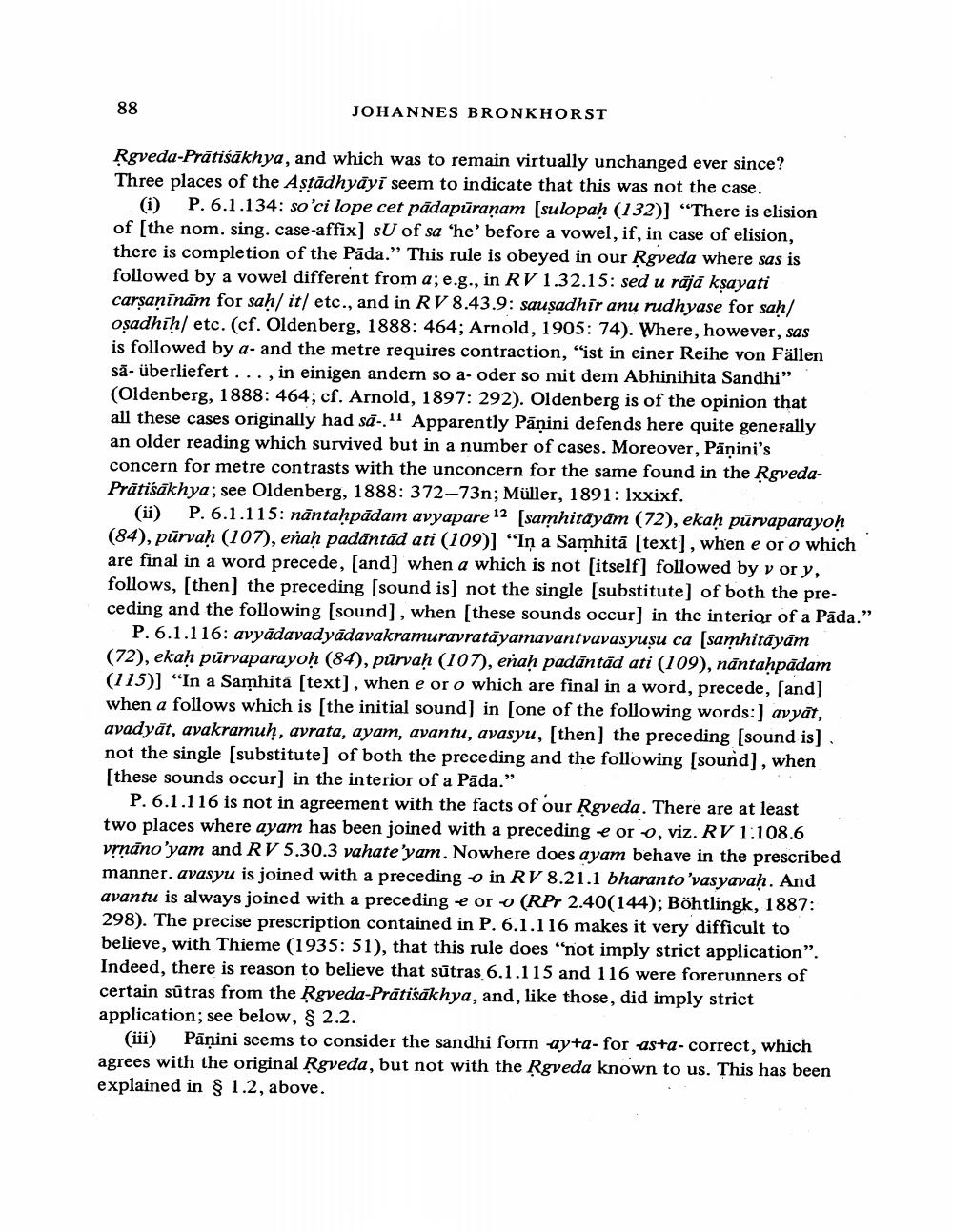________________
88
JOHANNES BRONKHORST
Rgveda-Prātiśākhya, and which was to remain virtually unchanged ever since? Three places of the Astādhyāyī seem to indicate that this was not the case.
(i) P. 6.1.134: so'ci lope cet pādapuranam (sulopaḥ (132)] “There is elision of the nom. sing. case-affix] SU of sa 'he' before a vowel, if, in case of elision, there is completion of the Pāda." This rule is obeyed in our Rgveda where sas is followed by a vowel different from a; e.g., in RV 1.32.15: sed u rājā kşayati carşaņīnām for sah/ it/ etc., and in RV 8.43.9: sausadhir anu rudhyase for sah/ oşadhih/ etc. (cf. Oldenberg, 1888: 464; Arnold, 1905: 74). Where, however, sas is followed by a- and the metre requires contraction, "ist in einer Reihe von Fällen să-überliefert ..., in einigen andern so a- oder so mit dem Abhinihita Sandhi" (Oldenberg, 1888: 464; cf. Arnold, 1897: 292). Oldenberg is of the opinion that all these cases originally had sā- 11 Apparently Pāṇini defends here quite generally an older reading which survived but in a number of cases. Moreover, Pāņini's concern for metre contrasts with the unconcern for the same found in the RgvedaPrātiśākhya; see Oldenberg, 1888: 372-73n; Müller, 1891: lxxixf.
(ü) P. 6.1.115: nāntaḥpādam avyapare 12 (samhitāyām (72), ekaḥ pūrvaparayoḥ (84), pūrvaḥ (107), enah padāntād ati (109)] "In a Samhitā [text], when e or o which are final in a word precede, [and] when a which is not [itself] followed by v or y, follows, (then) the preceding (sound is not the single (substitute) of both the preceding and the following (sound], when these sounds occur] in the interior of a Pada."
P. 6.1.116: avyādavadyādavakramuravratayamavantvavasyuşu ca [samhitāyām (72), ekaḥ purvaparayoḥ (84), pūrvaḥ (107), enah padāntād ati (109), nāntahpādam (115)] "In a Samhita [text], when e or o which are final in a word, precede, [and] when a follows which is the initial sound) in [one of the following words:) avyāt, avadyāt, avakramuḥ, avrata, ayam, avantu, avasyu, (then) the preceding (sound is) not the single (substitute] of both the preceding and the following (sound), when [these sounds occur] in the interior of a Pāda.”
P. 6.1.116 is not in agreement with the facts of our Rgveda. There are at least two places where ayam has been joined with a preceding e or 0, viz. RV 1.108.6 vrnāno'yam and RV 5.30.3 vahate'yam. Nowhere does ayam behave in the prescribed manner. avasyu is joined with a preceding o in RV 8.21.1 bharanto'vas yavah. And avantu is always joined with a preceding e oro (RPT 2.40(144); Böhtlingk, 1887: 298). The precise prescription contained in P. 6.1.116 makes it very difficult to believe, with Thieme (1935: 51), that this rule does not imply strict application”. Indeed, there is reason to believe that sutras 6.1.115 and 116 were forerunners of certain sūtras from the Rgveda-Prātiśākhya, and, like those, did imply strict application; see below, $ 2.2.
(iii) Pāņini seems to consider the sandhi form ayta- for asta-correct, which agrees with the original Rgveda, but not with the Rgveda known to us. This has been explained in § 1.2, above.




